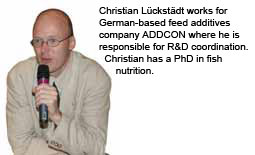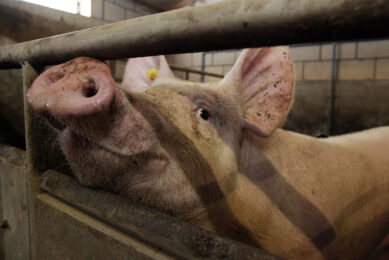Proper Salmonella control in pork production

Salmonella control has a high priority in European pork production. It is a significant cause of human Salmonellosis and causes major economic losses in the pork production chain, through reduced productivity, increased veterinary and hygiene control costs. Preventing the spread of salmonella to the consumer requires special control measures says Christian Lückstädt.
By Christian Lückstädt
S. enteritica Typhimurium is the predominant serotype of Salmonella that is found in pig carcasses in Europe, accounting for around 71% of the cases. Several serotypes are resistant to antibiotics, putting increasing pressure on producers to prevent contamination. A recent report reveals that, in an EU-wide survey published by EFSA, Salmonella was commonly detected in holdings with breeding pigs in most EU Member States. The survey was carried out in 24 Member States, Norway and Switzerland. On average, Salmonella was found in one out of three holdings although the survey says that figures vary greatly between countries.
Control measures
While Salmonella cannot be eradicated in pig units, it can be controlled to minimise the risk to consumers. Biosecurity plays a significant role in Salmonella control. In feed compounding, although heat treatment is effective in reducing contamination of feed leaving the feed mill, this effect does not persist during transport, storage and subsequent outfeeding. When conditions within the feed are less conducive to bacterial infection, Salmonella contamination can be reduced. The next critical control point is within the pig’s gut itself, where conditions for bacterial growth may once again be optimal. Salmonella growth requires warmth (35-37°C is optimal), a moisture content greater than 12% and a pH between 4.5-9.0. It is no coincidence that the pig gut can provide Salmonella everything it needs to thrive. Recent studies in Ireland and the UK support the growing body of scientific evidence that encouraging a healthy microflora in the intestine of pigs combats pathogens such as Salmonella.
Acidification of feed
While biosecurity and hygiene in the feed mill and on farm are essential, the acidification of feed ingredients or finished feeds with organic acids also offers considerable benefits to Salmonella control. Feed acidification is not only effective within the feed; possibly its biggest benefit occurs within the pig itself. Research trials in the UK with potassium diformate (KDF) shows significantly reduced Salmonella count in the feed as well as in the gut of pigs. This effect is particularly well illustrated by data collected on 12 farms in Ireland as part of a joint study undertaken by Teagasc, University College, Dublin and the Department of Agriculture and Food in Co. Kildare (Lynch et al., 2007). The main objective of this investigation was to evaluate the efficacy of Salmonella control measures on highly infected farms. Salmonella control has been compulsory under Irish law since 2002 and farm status is categorised by the percentage of positive pigs in a herd according to the Danish mix-ELISA test. Category 3 (>50% positive) farrow-to-finish farms and their associated fattening units were selected for the study. The effects of including KDF over the 24 months of the study are given in Table 1.
Results
All the farms that were treated with the additive alone; or a combination of KDF with improved hygiene and biosecurity measures (farms J and L) had notable improvements in both bacteriological and serological prevalence of Salmonella spp. All but one farm in which KDF was used ended the trial with a much improved Salmonella status, with bacteriological prevalence also low on most farms. Using improved hygiene and biosecurity measures alone also improved Salmonella status, but to a much lesser extent. These findings are not unique, however. Studies by the Danish feed company KFK (Olsen, 1999), the Veterinary University of Hanover (1999) and, more recently, in a commercial pig unit in the UK (Dennis and Blanchard, 2004), both concluded potassium diformate to be an effective tool in a Salmonella control strategy in commercial farms, reducing the percentage of salmonella positive pigs by 50% and in pork meat juice ELISA scores by 46%, respectively in grower finisher pigs (Dennis and Blanchard, 2004). The UK trial also showed an improvement in daily gain of 7.7%, reduced mortality and a reduction in medicinal intervention compared to the rolling average for that unit. The economic benefit of implementing Salmonella control, as detailed in the Salinpork 2000 research trial, was also evaluated. Excluding reductions in veterinary bills and culling rates that accompany Salmonella outbreaks, improvements in FCR of 3% and in daily live weight gain of 5%, potassium diformate addition to grower/finisher diets and improved hygiene management practices resulted in an estimated net benefit of GBP5,850 (€6,700) in an average herd (Blanchard and Burch, 2004).
Gut cell growth
Most recently, Visscher et al. (2009) demonstrated the potential of potassium diformate together with coarse feed particle size in supporting a healthy gut while reducing Salmonella prevalence.
The study proved that production of the short chain fatty acids propionate and butyrate was stimulated by KDF inclusion in the diet. Higher butyrate concentrations in the distal part of the digestive tract, especially in the colon, also support the growth and development of epithelial cells in the gut, increasing villus length and crypt depth – factors that induce healthy gut function. KDF also contributes to an optimal gut microflora in the last part of the gastro-intestinal tract of the pig via the promotion of butyrate production. The Danish study (Olsen, 1999), also showed a sustained effect of potassium diformate, even after removal of the additive from the feed. However, as Blanchard and Burch (2004) concluded that even though KDF use can be removed for 3-4 months without detrimental effect to Salmonella status, removal of the additive only proves effective once the original vector animals have been removed from the unit. The published results described above prove irrefutably how cost-effective Salmonella control, a healthy gut and food safety can be secured by dietary means.
Source: FeedMix vol 18 nr 1, 2010
Join 26,000+ subscribers
Subscribe to our newsletter to stay updated about all the need-to-know content in the feed sector, three times a week. Beheer
Beheer









 WP Admin
WP Admin  Bewerk bericht
Bewerk bericht